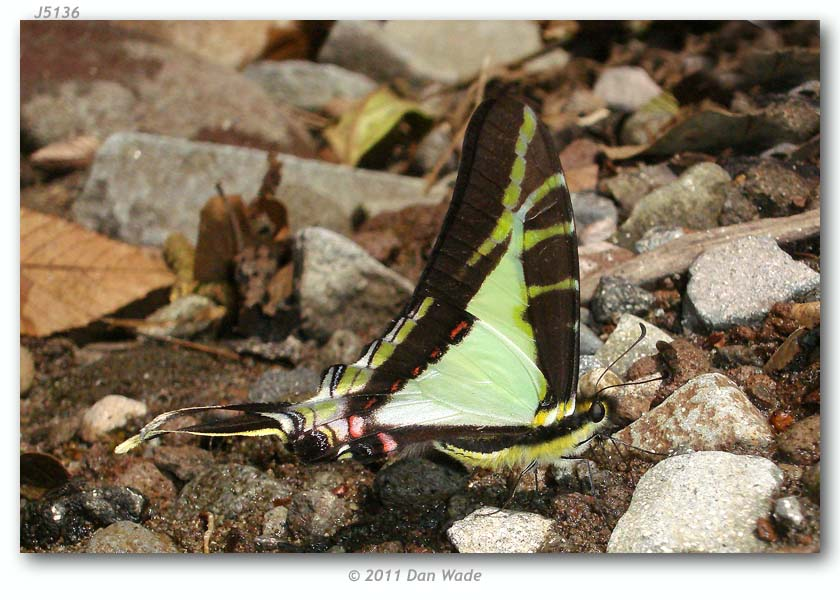The Yellow (or Orange) Kite Swallowtail is not, in fact, the bright yellow-orange Kite; its color is pale yellow, sometimes greenish or whitish, depending on the light and the degree of individual fading. Its wingspan is usually about three and a half inches.
Photo by Hakeen.
It is also called Eurytides calliste, or Protographium calliste. The most obvious result of changing the name, which some web sites are in process of doing this summer, is to make photos and articles about an already obscure species even harder to find. Eurytides refers to the "broad shape" of its wings, in contrast to the Longwings. Protographium means "the first, earliest, Graphium" and refers to a belief that the South American Kite Swallowtails evolved earlier than the Asian Swordtails. Calliste means "the most beautiful." The tradition in naming Swallowtail species used to be to name them after characters in ancient literature, and several characters were called Calliste, or Callista, or Callisto.
In Spanish they are cometa, or mariposa de cola golondrina (two translations for "Swallowtail butterfly") amarilla. Another name found at some sites is cebra. This is unnecessarily confusing because Eurytides or Protographium marcellus, the Zebra Swallowtail, is found in some parts of Mexico and is a completely different species--though the species are considered to be "related."
Widespread in Central and South America, calliste seems to be uncommon and, even in places where some claim it is threatened, not well documented. The Guatemalan government lists it as a threatened, protected species:
The species as a whole is "not known to be threatened." It seems close to being not known at all. It seems somehow typical that a web search for scientific papers about this species pulls up papers like the one linked below. (After a short summary in English, the main substance of the paper is in Spanish/) Calliste is mentioned in a reference note; the paper is about Mexico's wealth of butterfly habitat and species. In fact Mexico already has established Monarch butterfly habitat as a worldwide tourist destination, and could easily add other species to the butterfly enthusiasts' itineraries.
It can be confused with the species dioxippus. According to the Swift Guide, the two species look almost alike but show a consistent difference in the thin yellow stripes in the dark borders of the underides of the forewings. Calliste's stripes cross the black band; dioxippus's don't.
There is a subspecies, Protographium calliste olbius. It is on average slightly larger, and has slight differences in the color pattern. There is some size and color variation among individuals but P. calliste calliste, from Mexico and Guatemala, show consistent variation from P. c. olbius from Costa Rica and Panama.
The food plant for calliste is believed to be Magnolia dealbata, the cloudforest magnolia. This big tree could easily host several solitary caterpillars in a season, and no other caterpillar feeds on it.. However, although we have seen photo evidence that some of the Kite Swallowtails do not require a great deal of space, some butterfly species in this family are known to have habits that keep their distribution sparse. One of the first things I observed about butterflies as a child was that Zebra Swallowtails will join big flocks of Tiger Swallowtails and other species at puddles, but you never see more than two Zebras together. Brighter yellow Eurytides salvini are said to chase each other away from puddles, and North America's Eurytides or Protographium marcellus are one of those shell-eating species in which the caterpillars' natural instinct to eat their own outgrown skins is not offset by any instinct to back off when they find a skin of their own species while a sibling is living in it. Fratello complains that where Graphium species he was studying formed great flocks at puddles, the Eurytides he was studying on a trip through Central America seemed to travel by ones. Butterflies that depend totally on a single food plant can rarely afford to live close together.
Photo by Michael Graupe. No one seems ever to have described the differences between male and female in this species. If my guess is correct about calliste's social behavior resembling marcellus's, the fact that these two are sipping water close together may indicate that the differences in their patterns are secondary sex characteristics. (You don't see marcellus fighting; you see them looking for places where each one can be the only male or female marcellus n the neighborhood. They are somewhat rare. Note, however, that in a few places where their food plant, Asimina triloba, is abundant some people do claim to have seen marcellus in flocks.)
Though they are, like many butterflies, most easily photographed sipping water from puddles, Kites also sip nectar from flowers. Here is calliste's claim to pollinator species status:
No one seems ever to have documented the life cycle of these butterflies. They're pretty, they're somewhat useful to humans, and they live in places where other butterflies are even more attention-catching. Usually Swallowtails command lots of attention, but when the competition for attention includes Monarchs and Morphos and Blue Swallowtails...





No comments:
Post a Comment